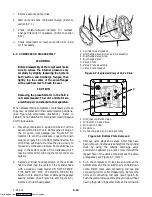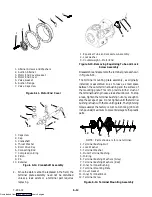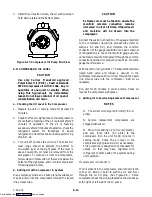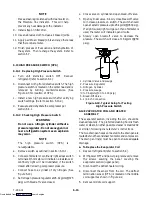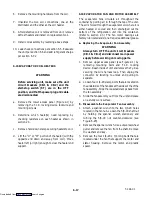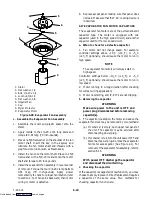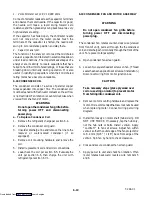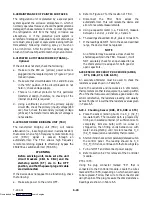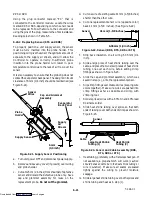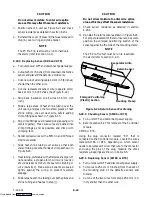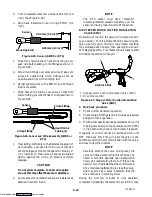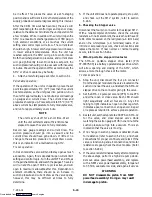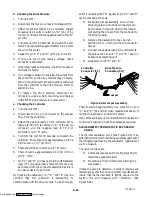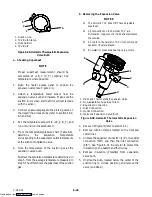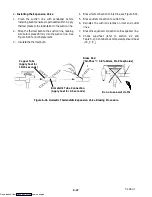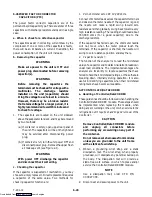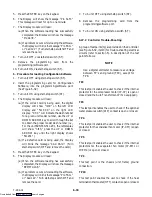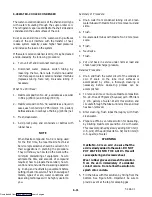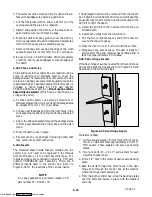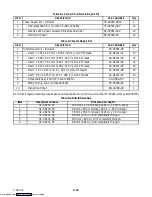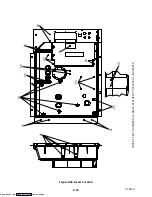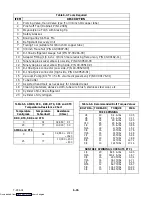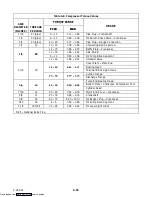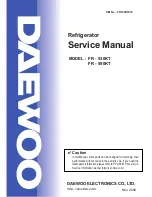
6-24
T-294-01
be in effect. This places the valve at a 21% staging
position and is sufficient to drive the temperature of the
supply probe down several degrees during this interval.
After the CREL time-out has been met, the valve will
start responding to the control logic and open or close,
relative to the demand. Scrutinize the unit operation for
a few minutes. While in pulldown the unit will open the
SMV to a maximum discharge pressure of 350 psig in
high ambient conditions, or as much as the current
setting and control logic will allow. The current level
should be high. A lower discharge pressure will be seen
in lower ambient temperatures. Once the unit has
reached set point, the SMV will go into control mode.
Both the discharge/suction pressures, and current draw
will go significantly lower. Once below set point, the
suction pressure should go into a vacuum within several
minutes. Should the operation differ as mentioned, the
SMV or drive module may be faulty.
4. Attach a manifold gauge set, refer to section 6.1.
Perishable operation:
If the operation of the unit is in question, place the set
point to approximately 6
°
C (11
°
F) less than the current
box temperature, so the unit goes into pulldown. Run
the unit for approximately one minute. Record readings
on gauges and current draw. The current draw and
pressures should go up. Place set point to 0.5
°
C (0.9
°
F)
above current box temperature to fully modulate valve,
and run for approximately one minute.
NOTE
The unit may shut off for a short time. Wait
until the unit self starts and sufficient time has
elapsed to cause the valve to fully modulate.
Record new gauge readings and current draw. The
suction pressure should go into a vacuum and the
current draw should have gone down. If little or no
change to the suction pressure or current draw occurs,
this is an indication of a malfunctioning SMV.
Frozen operation:
In frozen mode the valve will tend to stay open as much
as possible. Again, this is dependent upon current limit
setting and control logic. Turn the unit OFF and ON, as
in the perishable mode, and watch the gauges. The valve
will run at 21% open if CREL logic is active, and will
open to maximum allowable after this. Dependent on
ambient conditions, there should be an increase in
suction pressure and current draw as the valve opens,
however, this may be difficult at times to fully
determine.
5. If the unit still does not operate properly, stop unit,
and check out the SMV system, refer to section
6.24.b.
b. Checking the Stepper valve
Disconnect the four pin connector to the stepper SMV.
With a reliable digital ohmmeter, check the winding
resistance. In normal ambient, the valve should have 72
to 84 ohms measured on the red/green (a-b terminals)
and on the white/black (c-d terminals) leads. If an
infinite or zero reading occurs, check connections and
replace the motor. If near normal or normal reading
occurs, refer to section 6.24.e.
c. SMA-12 portable stepper drive tester
The SMA-12 portable stepper drive tester (P/N
07-00375-00) is a battery operated stepper drive which
will allow opening and closing of the SMV, which
allows a more thorough check of the motor.
To check operation:
1. Stop the unit, disconnect the four pin connector
from the stepper module to the valve located on the
suction line near the valve, and attach the SMA-12
stepper drive to the connector going to the valve.
2. Set the SMA-12 pulse per second (PPS) to one PPS
and either open or close valve. Each LED should
light sequentially until all four are lit. Any LED
failing to light indicates an open on that leg which
indicates a poor connection or an open coil. Repair
or replace as required to achieve proper operation.
3. Restart unit, set the step rate to 200 PPS on SMA-12
for the valve, and close stepper valve while
watching the suction gauge. Within one minute the
suction pressure will go into a vacuum. This is an
indication that the valve is moving.
4. If no change in suction pressure is detected, check
for resistance (refer to section 6.24.b.), and check
connections for proper continuity and retest. If the
valve is functioning and all connections and motor
resistance are good, check the drive module. (Refer
to section 6.24.d.)
5. If the valve is determined as faulty after completing
the above steps, perform a high side pump down.
Remove valve powerhead assembly, and replace
with a NEW valve powerhead assembly, torque nut
to 35 ft-lb, evacuate low side, and open all valves.
WARNING
DO NOT disassemble piston from NEW
powerhead assembly! Doing so may result
in damage to piston.
Downloaded from

